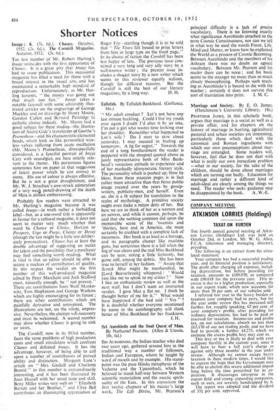Shorter Notices THE last number of Mr. Robert Harling's Image
coincides with the first appearance of Chance. It is a great pity that Image has had to cease publication. This occasional magazine has filled a need for those with a broad interest in the visual arts, and has maintained a remarkably high standard of reproduction. Unfortunately, as Mr. Har- ling laments, " the money was going out that much too fast." image takes a notable farewell with some admirably illus- trated articles on the engravings of George Mackley and on drawings by Henry Moore, Gordon Cullen and Bernard Partridge (a catholic choice indeed). Mr. Moore had a good subject for these studie—the illustra- tion of Andre Gide 's translation of Goethe's Prometheus—and his characteristic elemental heads, which look so like personified wire- less valves stiffering from acute oscillation (Mr. Moore's Prometheus, disrespectfully considered, is a fanciful portrait of Joyce Cary with neuralgia), are here strictly rele- vant to the theme. His portentous figures sometimes hint on paper at that suggestion of latent power which he can convey in stone. His use of colour is always effective. But he is not a great draughtsman, and Mr. W. J. Strachan's awe-struck admiration of a very -weak pencil-drawing of the death of Mira is almost embarrassing.
Probably few readers were attracted to Mr. Harling's magazine because it was called Image—in truth rather a forbidding label—but, as a one-word title is apparently in favour for a cultural magazine, it does not seem to matter very much whether that word be Chance or Choice, Horizon or Prospect, Urge or Purge, Change or Decay (though the last might be a little too deliber- ately provocative). Chance has at least the double advantage of suggesting an outlet for talent and the possibility that a purchaser may find something worth reading. What is vital is that an editor should be able to secure a nucleus of contributors of quality. In this respect the verdict on the first number of this well-produced magazine edited by Peter Marchant and Jack Stafford must, naturally enough, be " not proven." There are contributions from Wolf Manko- witz, Tom Hopkinson and George Watkins which are highly encouraging for its future ; there are other contributions which are painfully derivative and uninspired. The illustrations are not, on the whole, impres- sive. Nevertheless, the attempt wis necessary and must be welcomed. A second number may show whether Chance is going to sink or swim.
The Cornhill, now in its 993rd number, faces the same problems of high production costs and small circulation which confront Chance and defeated Image. It has the advantage, however, of being able to call upon a number of contributors of proved ability and distinction. Margaret Lane's article on " Mrs. Gaskell and Charlotte Bronte " in this number is extraordinarily interesting, and it has been illustrated by Joan Hassan with her usual taste and skill. Betty Miller writes very well on " Elizabeth Barrett and her Brother," and Clive Bell contributes an illuminating appreciation of Roger Fry—startling though it is to be told that " The Times felt bound to print letters from him in large type on the front. page." In its choice of fiction the Cornhill has been less happy of late. The previous issue con- tained a very long and very silly story by a well-known writer ; the; present issue in- cludes a sho;ter story by a new writer which • seems to this reviewer equally tedious, though for different reasons. But the Cornhill is still the best of our literary magazines, by a long way. D. H.


































 Previous page
Previous page